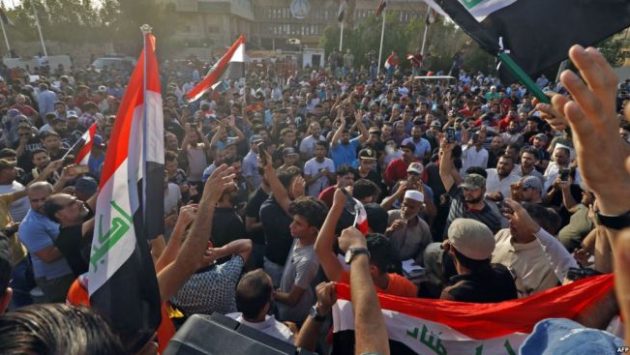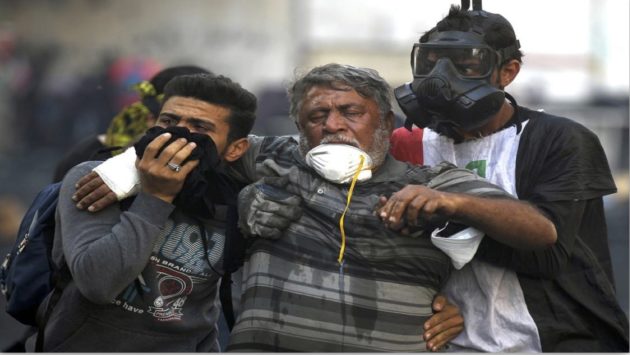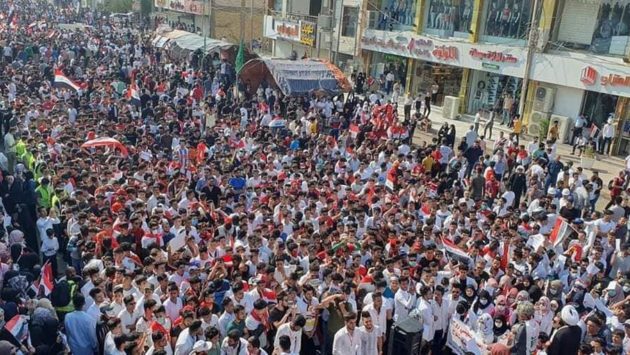After 5 Months, Iraq Demonstrations Exceed All Expectations
2 March 2020
In a diverse country like Iraq, one rarely finds an event that has almost unanimous popularity, but the Iraqi demonstrations, which began lat October and continue today, have found just this kind of universal support. These peaceful demonstrations have exceeded all the expectations of researchers, observers, and even Iraqi officials, many of whom had bleak predictions in the earliest days, expressing pessimism about protesters’ ability to sustain their determination and perseverance, and skepticism about the possibility of achieving any of their goals. The idea that massive nonviolent protests might change the political situation in the country seemed to most an impossible dream: the demonstrations might have limited success, for instance they might bring about changes in the provision of basic services (with no guarantee that such changes would last), but most watching Iraq in October described what was going on there as a mere “outburst,” likely linked to political infighting. Early observers ignored the massive popularity and youthful spontaneity that was — and continues to be — the foundation of this revolutionary movement.
Whether the “Iraqi Revolution” as the peaceful demonstrators in Karbala, Nasiriyah and Basra like to call it, or the “October Uprising,” described by nonviolent protesters in Muthanna, Maysan, and Najaf, or a “revolution of consciousness,” as the protesters refer to it today in Baghdad’s Tahrir Square — all Iraqi observers and activists can now list a long series of goals they have obtained due to their active dedication to their cause, now entering its sixth month. These enormous advancements have been achieved in several different contexts: political, social and economic. The steadfast resolve of the protesters seems boundless, despite their sorrow for the loss of too many of their colleagues who have been senselessly killed over the past months. The peaceful demonstrators have been met with repressive violence from Iraqi authorities (including kidnappings and assassinations), and this violence continues though officials are working hard to conceal just how widespread it is.
The latest leaks indicate that the number of victims in the Iraqi demonstrations has reached nearly 650, the youngest of whom was a twelve-year-old boy who died in Nasiriyah, and the oldest, a 70 year old sheikh killed in Karbala. Women are also represented in these alarming statistics: records from the Ministry of Health indicate that among the total dead about 10 are women, including those who were offering first-aid, university students and activists. The latest of these was a peaceful protester in Basra, called “the nun of Basra” after she became famous for providing first aid to the protesters and preparing food for them. A procession was held in her honor beginning in front of her tent in the center of the Navy Square in the city and ending in her final resting place in Wadi Al Salam in the city of Najaf.
Muhammad Shia Al-Sudani, one of the candidates most likely to take over the Iraqi government after Adel Abdul-Mahdi and his government were forced to resign in response to the massive nonviolent demonstrations, acknowledges the positive aspects of the movement, though he is unpopular with many demonstrations, many of whom have raised serious doubts about his assuming the role of prime minister. In an interview with Al-Arabi Al-Jadeed, Al-Sudani said that “the October demonstrations are a popular movement that represents a growing state of Iraqi awareness which cannot be separated from the demonstrations of 2011, 2015 and 2017. They are, overall, representative of the mobility of Iraq’s younger generation during a period of crises that has led to a sharp rise in unemployment and poverty. Administrative and financial corruption, poor services, lack of justice and weak rule of law have all played a role in leading us to this point.” In his opinion, this generation “is in constant communication with the world beyond Iraq’s borders, and it is monitoring the development and progress of the Iraqi people. These young Iraqis believe that their country is still mired in problems, and they are now asking for answers as to who or what is behind this.”
Al-Sudani went on to explain that, in his view, “the Iraqi political forces did not listen to the voice of this generation, but rather formed the Madhi government which was dominated by entrenched political blocs established through a corrupt system of quotas. This government,” he went on, “has used corruption and cronyism and the seizure of public money to undermine the institutions of the state. This has caused the government and its officials to lose prestige, and is is the reason why the October Uprising erupted.” He went on to point out that “the demonstrations started with demands for basic services, but they’ve ended up calling for radical political reform.” The possibility of genuine reform has galvanized the Iraqi people, solidarity with demonstrators has crossed age, gender, religious and political lines, earning respect from all parts of society.”
On the most prominent results of the uprising, according to Al-Sudani, is that it “has prioritized Iraqi national identity over sub-national, sectarian and regional identities. This has made for a strong sense of patriotism and a feeling of belonging within the country.” He also noted that peaceful protesters were calling for “a homeland in which sovereignty, justice, equality and dignity prevail; in short, a country that preserves the rights of all.” Among other achievements of the movement, in his opinion, are political reforms that would not have been achieved had not it not been for the demonstrations. There have been public debates about forming a committee to amend the constitution, as well as important new legislation, such as the Parliament’s new election law and the election commission law.
As for what is needed, Al Sudani believes that “the movement must formulate specific goals and must itself turn into a unified political actor if it wants to secure a presence in the early elections.” Al-Sudani insists that “in order translate this movement into an effective political force, it is important that it be active in Parliament and in state institutions. The movement must become a genuine partner in the reform process until its desired goals are reached: that is, Iraq as a sovereign state with a functioning democracy and institutions that protect all citizens without the influence of partisan groups and parties. This is the goal that everyone is calling for, and it will be achieved only if the movement can remain active and work with clarity and focus for change in the future.”
Meanwhile, Sheikh Muhammad Abbas Al-Tamimi, a prominent leader from one of the tribes in Basra, stated in an interview with Al-Arabi Al-Jadeed that the demonstrations prove that the Iraqi people are committed and undeterred, they are still protesting despite campaigns of repression and abuse and attempts to draw them into violence. The youth who are driving these peaceful protests reject violence, despite the abundance of weapons available on the streets of Iraq. “We’ve won a lot of important victories through these demonstrations, we’ve come together as a country and as a people. If not for the martyrs and the injured, we might have called this the Iraqi wedding,” Tamimi said. He also talked about “winning over patriotic, non-sectarian, and honest youth who dream of a homeland without interference from Iranian or American agents. More important, they must discover that a fixed and corrupt political class is not the inevitable fate for Iraqis, there will be no new Saddam Hussein.” In particular, southern Iraq “has proven that it is independent and Arabic, the master of itself, including Qadisiyah and Dhi Qar.”
Activist Ali Ghaleb from Baghdad believes that the Iraqi demonstrations have produced a new situation within society, one which has directly impacted the political process. In an interview with Al-Arabi Al-Jadeed, he stated that the peaceful protesters have “restored the confidence of the Iraqi people themselves and their ability to change and improve everyday life for everyone in Iraq. Since 2003, Iraqis have been pushed out of control of their own lives, but today, through these demonstrations, they take this control back.” As for the future, Ghaleb considers that “the success of the people in managing the current demonstrations ensures their success in managing other, bigger issues.” Comparing the achievements of the movement with political activities that have taken place in the past, the Iraqi activist believes that “the demonstrations have managed to achieve what the National Reconciliation Commission was unable to achieve, as well as the so-called reconciliation conferences, workshops and seminars that have consumed hundreds of millions of dollars since 2006.”
Abbas Jumaa Al-Waeli, an activist in Nasiriyah, the capital of Dhi Qar Governorate in the south of the country, the most active governorate of the Iraqi demonstrations, confirms that there is a desire amongst a large part of the demonstrators to continue to demonstrate, even if all their demands are implemented because the movement has “washed away a lot of the residue of the American occupation.”
Al-Waeli, keen to show pictures on his phone taken in the first days of the demonstration when he was shot in the shoulder, reported to Al-Arabi Al-Jadeed that “Iraq before the demonstrations is not the same place as it is now.” He never expected that Iraq would get attention from other Arab countries, especially relating to what is happening in the southern provinces: ”The interaction and sympathy of Arab citizens with our victims and their support through social media has proven how close we are to each other. This unity stands in contrast to the image held by most of us, formed through the sectarian partisan media in Iraq.”
Iraqi activists and observers have a long list of the demonstrations’ positive outcomes since they began, perhaps the most prominent is the rise in the sense of a shared national identity and a decline in what Iraqis call “sectarian shops.” Public discourse based on sectarian and regional entrenchment, usually fraught with hate, racism and discrimination is disappearing and being replaced with a sense that all Iraqi’s share a common identity that transcends their individual ones. It is known, for example, that the Almoravids stationed in Tahrir Square in Baghdad were threatened with government repression or attacks by armed groups. Still they stayed a number of days and in this showed their high degree of loyalty to the homeland. Among the most important achievements, according to activists and observers, is to drop all symbolic, political and even religious divisions and stand united under the slogan “There is nothing sacred but the homeland.” And indeed, the aura surrounding many political leaders has dissolved, while others have simply lost stature, and this is true as well for many religious and militia leaders. We see this loss of faith reflected in the burning of 178 headquarters and offices of armed parties, political movements, and armed factions in central and southern Iraq, according to data from the Ministries of the Interior and the Joint Iraqi Operations Command.
Perhaps one of the most important results of this popular movement in Iraq is the restoration of an accurate image of community in the southern part of the country where a distorted sense of the people and their loyalties had been fortified by foreign and Arab media outlets. This includes Iranian interference which aimed to give the sense of intense loyalty to Tehran and an acceptance of Iranian influence and hegemony in southern Iraq. The first images that were burned to challenge this false idea were those of the Iranian leader, Ali Khamenei, in Karbala and Najaf, two holy Iraqi cities. The demonstrators also stormed the two Iranian consulates, closing them in both cities. After the demonstrators climbed their walls and burned the Iranian flag, they raised the Iraqi flag instead. Banners were distributed throughout southern Iraq, rejecting Iranian interference and voicing opposition to Khamenei and the leader of the “Quds Force” in the Revolutionary Guards, Qassem Soleimani, who was killed earlier this year by an American raid in Baghdad.
One of the results of the Iraqi demonstrations as it enters its sixth month — in addition to the overthrow of the Mahdi government, parliament’s agreement to enact new election laws, the establishment of an Electoral Commission and amending the constitution — is the breaking of an Iraqi expectation that has been in place since 2011: no demonstration can sustain itself without political support from one of the established parties. This referred to the “Sadrist movement” and the Iraqi Communist Party, which has members (both administrative and ideological) in Baghdad and the south. But the current demonstrations began spontaneously, its heroes are a group of young men who called out to others using Facebook, only to find many more than they could have ever dreamed of were waiting for them between the Tayaran and Tahrir areas in central Baghdad, all ready to demonstrate on the first day of October 2019. The authorities’ repression of these activists did not dissuade them — on the contrary, it led to a rise in the number of nonviolent demonstrators. The numbers of peaceful protesters grew by the hour and spread from the first day, through the air, to Karbala, to Najaf, to Dhi Qar, to Basra, and the rest of the southern Iraqi cities. These facts put Iraqis themselves in the dominant position today, common citizens are calling the shots. They have proven their strength and resolve, they know how to protest and if shut down by authorities in one public square, they will simply start again in another. No one is forcing the demonstrators to continue, they can leave at any time. It is up to them to determine the place and time of their protests. As a result, the political parties are thrust into a defensive stance, and they must now justify mistakes they’ve made.
The observer of Iraq today does not long for the days before the demonstrations began. The successes are too many, the sense of hope and solidarity, too strong. One can now see a remarkable return of Iraqi goods to local markets. The Baghdad Chamber of Commerce reports that Iraqi goods have become the country’s favorite, preferred over Iranian or Turkish products. Chamber member Mohammed Hussein Fadel said in an interview with Al-Arabi Al-Jadeed that the demand for Iraqi production by citizens is increasing, reinforcing a “growing feeling of national pride and unity, which is directly in line with the aims of the demonstrations.”




